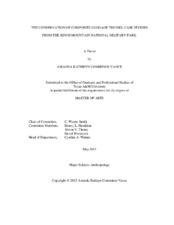The Conservation of Composite Luggage Trunks: Case Studies from the Kings Mountain National Military Park
Abstract
The primary reason for conserving artifacts, archaeological or historical, is the preservation of information contained in those artifacts for future study. This thesis presents information on how to treat large, dry, composite artifacts using silicone oil while avoiding the invasive, possibly damaging, disassembly of constituent parts.
It explores treatments of conservation for large composite artifacts using three luggage trunks from the Kings Mountain National Park as case studies. Conservation of these trunks was part of a larger project completed at Texas A&M University’s Conservation Research Laboratory.
A strategy used in the conservation of composite artifacts comprised of organic materials is use of polymers, specifically silicone oil. Silicone oil was used as the main treatment of the organic elements. Different catalyst methods were experimented with to treat different materials. In combination with the silicone oil, established treatments appropriate to the inorganic (metal) materials were used. This thesis also explored advantages and disadvantages of dismantling an artifact for treatment.
Implementing either preservation, restoration or dismantling the conservation methodology for this study was to actively remove agents of deterioration and stabilize the artifacts to prevent future deterioration and to retain their integrity.
This study found that although the use of different catalysts could be beneficial, results were mixed. Although known undesirable results were avoided, in certain instances the experimental catalyst produced different undesirable effects. More in depth study would be required to ascertain if these results are avoidable or reversible. When possible, dismantling of an artifact should be avoided. In some cases however, it is more important to conserve the whole object at the expense of a particular part. Lastly, the findings of this study support the use of established conservation treatments in conjunction with more experimental methods. Treatments that do not conflict with others or un-do the results of each other can effectively be used to more completely treat composite artifacts.
Citation
Vance, Amanda Kathryn Comminos (2015). The Conservation of Composite Luggage Trunks: Case Studies from the Kings Mountain National Military Park. Master's thesis, Texas A & M University. Available electronically from https : / /hdl .handle .net /1969 .1 /154983.


